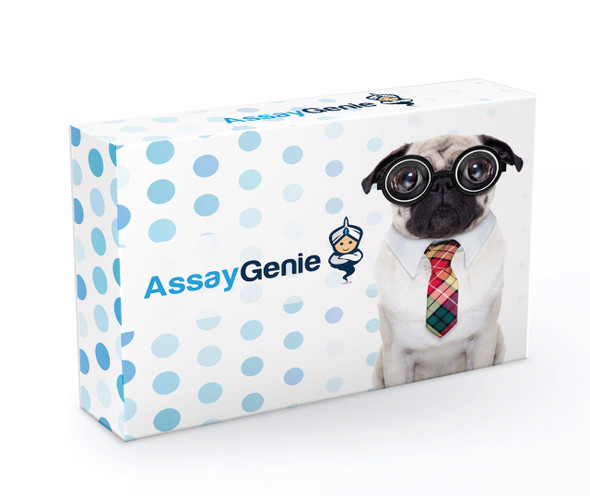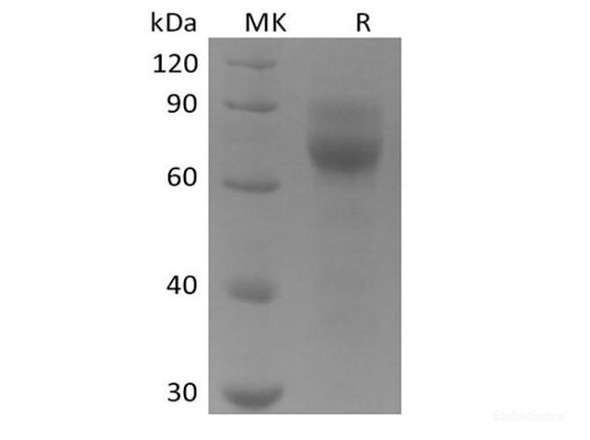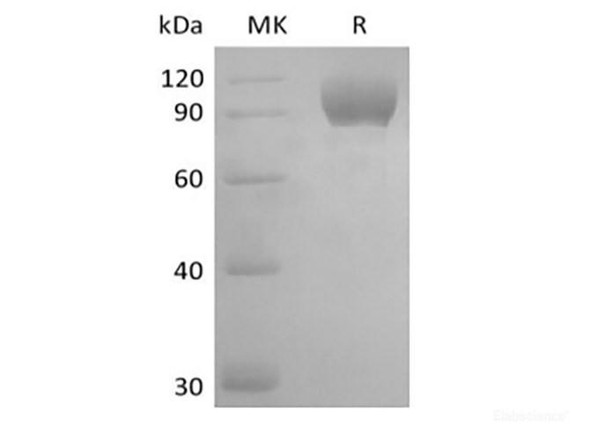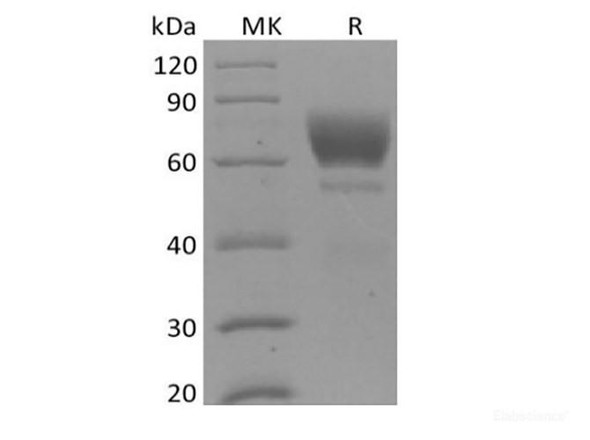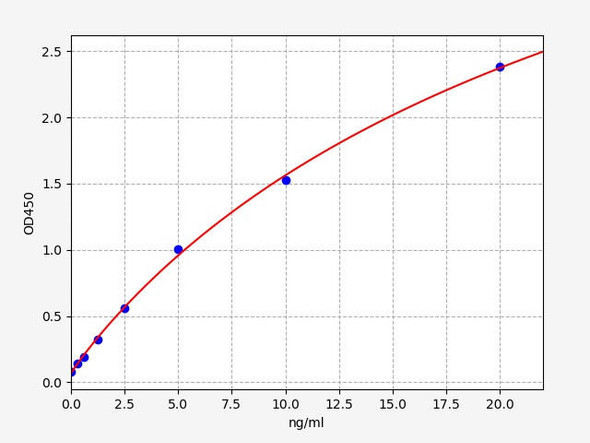Description
Human AXL (Tyrosine-protein kinase receptor UFO) ELISA Kit (HUFI07989)
The Human AXL (Tyrosine Protein Kinase Receptor UFO) ELISA Kit is a reliable and accurate tool for detecting AXL levels in human serum, plasma, and cell culture supernatants. This kit offers high sensitivity and specificity, ensuring precise and consistent results for various research applications.AXL is a key receptor tyrosine kinase involved in regulating cell growth, migration, and survival. Dysregulation of AXL signaling has been linked to various diseases, including cancer, autoimmune disorders, and cardiovascular diseases.
Therefore, measuring AXL levels can provide valuable insights into these conditions and aid in the development of targeted therapeutic strategies.Overall, the Human AXL ELISA Kit is a valuable resource for researchers studying AXL signaling pathways and exploring its potential as a therapeutic target in various disease processes.
| Product Name: | Human AXL (Tyrosine-protein kinase receptor UFO) ELISA Kit |
| Product Code: | HUFI07989 |
| Size: | 96 Assays |
| Alias: | AXL ELISA Kit, AXL oncogene ELISA Kit, AXL receptor tyrosine kinase ELISA Kit, JTK11 ELISA Kit, UFO ELISA Kit |
| Detection method: | Sandwich ELISA, Double Antibody |
| Application: | This immunoassay kit allows for the in vitro quantitative determination of Human AXL (Tyrosine-protein kinase receptor UFO) concentrations in serum plasma and other biological fluids. |
| Sensitivity: | < 0.094ng/ml |
| Range: | 0.156-10ng/ml |
| Storage: | 4°C for 6 months |
| Note: | For Research Use Only |
| Recovery: | Matrices listed below were spiked with certain level of Human AXL (Tyrosine-protein kinase receptor UFO) and the recovery rates were calculated by comparing the measured value to the expected amount of Human AXL (Tyrosine-protein kinase receptor UFO) in samples. Enquire for more information. |
| Linearity: | The linearity of the kit was assayed by testing samples spiked with appropriate concentration of Human AXL (Tyrosine-protein kinase receptor UFO) and their serial dilutions. The results were demonstrated by the percentage of calculated concentration to the expected. Enquire for more information. |
| CV(%): | Intra-Assay: CV<8% Inter-Assay: CV<10% |
| Component | Quantity | Storage |
| ELISA Microplate (Dismountable) | 8×12 strips | 4°C for 6 months |
| Lyophilized Standard | 2 | 4°C/-20°C |
| Sample/Standard Dilution Buffer | 20ml | 4°C |
| Biotin-labeled Antibody(Concentrated) | 120ul | 4°C (Protect from light) |
| Antibody Dilution Buffer | 10ml | 4°C |
| HRP-Streptavidin Conjugate(SABC) | 120ul | 4°C (Protect from light) |
| SABC Dilution Buffer | 10ml | 4°C |
| TMB Substrate | 10ml | 4°C (Protect from light) |
| Stop Solution | 10ml | 4°C |
| Wash Buffer(25X) | 30ml | 4°C |
| Plate Sealer | 5 | - |
Other materials and equipment required:
- Microplate reader with 450 nm wavelength filter
- Multichannel Pipette, Pipette, microcentrifuge tubes and disposable pipette tips
- Incubator
- Deionized or distilled water
- Absorbent paper
- Buffer resevoir
| UniProt Protein Function: | AXL: a receptor tyrosine kinase that may function as a signal transducer between specific cell types of mesodermal origin. Interacts with SKP1. Overexpression in tissue culture causes oncogenic transformation. Overexpressed in several cancers including thyroid, ovarian, gastric, ER+ breast cancer and acute myeloid leukemia, where it is associated with poor prognosis. 2 isoforms of the human protein are produced by alternative splicing. |
| UniProt Protein Details: | Protein type:Oncoprotein; Protein kinase, tyrosine (receptor); Protein kinase, TK; Kinase, protein; EC 2.7.10.1; Membrane protein, integral; TK group; Axl family Chromosomal Location of Human Ortholog: 19q13.1 Cellular Component: cell surface; extracellular space; integral to plasma membrane; intracellular; plasma membrane Molecular Function:ATP binding; phosphatidylserine binding; protein binding; protein heterodimerization activity; protein-tyrosine kinase activity; transmembrane receptor protein tyrosine kinase activity; viral receptor activity Biological Process: apoptotic cell clearance; blood vessel remodeling; cell maturation; cellular response to extracellular stimulus; entry of virus into host cell; erythrocyte homeostasis; forebrain cell migration; inflammatory response; innate immune response; natural killer cell differentiation; negative regulation of interferon-gamma production; negative regulation of lymphocyte activation; negative regulation of neuron apoptosis; negative regulation of tumor necrosis factor production; neuron migration; ovulation cycle; peptidyl-tyrosine phosphorylation; phagocytosis; platelet activation; positive regulation of cytokine and chemokine mediated signaling pathway; positive regulation of natural killer cell differentiation; positive regulation of pinocytosis; positive regulation of protein kinase B signaling cascade; protein kinase B signaling cascade; secretion by cell; signal transduction; spermatogenesis; vagina development; vascular endothelial growth factor receptor signaling pathway |
| NCBI Summary: | The protein encoded by this gene is a member of the Tyro3-Axl-Mer (TAM) receptor tyrosine kinase subfamily. The encoded protein possesses an extracellular domain which is composed of two immunoglobulin-like motifs at the N-terminal, followed by two fibronectin type-III motifs. It transduces signals from the extracellular matrix into the cytoplasm by binding to the vitamin K-dependent protein growth arrest-specific 6 (Gas6). This gene may be involved in several cellular functions including growth, migration, aggregation and anti-inflammation in multiple cell types. Alternative splicing results in multiple transcript variants of this gene. [provided by RefSeq, Jul 2013] |
| UniProt Code: | P30530 |
| NCBI GenInfo Identifier: | 239938818 |
| NCBI Gene ID: | 558 |
| NCBI Accession: | P30530.3 |
| UniProt Secondary Accession: | P30530,Q8N5L2, Q9UD27, |
| UniProt Related Accession: | P30530 |
| Molecular Weight: | 97,377 Da |
| NCBI Full Name: | Tyrosine-protein kinase receptor UFO |
| NCBI Synonym Full Names: | AXL receptor tyrosine kinase |
| NCBI Official Symbol: | AXL |
| NCBI Official Synonym Symbols: | ARK; UFO; JTK11; Tyro7 |
| NCBI Protein Information: | tyrosine-protein kinase receptor UFO |
| UniProt Protein Name: | Tyrosine-protein kinase receptor UFO |
| UniProt Synonym Protein Names: | AXL oncogene |
| Protein Family: | Tyrosine-protein kinase receptor |
| UniProt Gene Name: | AXL |
| UniProt Entry Name: | UFO_HUMAN |
*Note: Protocols are specific to each batch/lot. For the correct instructions please follow the protocol included in your kit.
Before adding to wells, equilibrate the SABC working solution and TMB substrate for at least 30 min at 37 °C. When diluting samples and reagents, they must be mixed completely and evenly. It is recommended to plot a standard curve for each test.
| Step | Protocol |
| 1. | Set standard, test sample and control (zero) wells on the pre-coated plate respectively, and then, record their positions. It is recommended to measure each standard and sample in duplicate. Wash plate 2 times before adding standard, sample and control (zero) wells! |
| 2. | Aliquot 0.1ml standard solutions into the standard wells. |
| 3. | Add 0.1 ml of Sample / Standard dilution buffer into the control (zero) well. |
| 4. | Add 0.1 ml of properly diluted sample ( Human serum, plasma, tissue homogenates and other biological fluids.) into test sample wells. |
| 5. | Seal the plate with a cover and incubate at 37 °C for 90 min. |
| 6. | Remove the cover and discard the plate content, clap the plate on the absorbent filter papers or other absorbent material. Do NOT let the wells completely dry at any time. Wash plate X2. |
| 7. | Add 0.1 ml of Biotin- detection antibody working solution into the above wells (standard, test sample & zero wells). Add the solution at the bottom of each well without touching the side wall. |
| 8. | Seal the plate with a cover and incubate at 37 °C for 60 min. |
| 9. | Remove the cover, and wash plate 3 times with Wash buffer. Let wash buffer rest in wells for 1 min between each wash. |
| 10. | Add 0.1 ml of SABC working solution into each well, cover the plate and incubate at 37 °C for 30 min. |
| 11. | Remove the cover and wash plate 5 times with Wash buffer, and each time let the wash buffer stay in the wells for 1-2 min. |
| 12. | Add 90 µL of TMB substrate into each well, cover the plate and incubate at 37 °C in dark within 10-20 min. (Note: This incubation time is for reference use only, the optimal time should be determined by end user.) And the shades of blue can be seen in the first 3-4 wells (with most concentrated standard solutions), the other wells show no obvious color. |
| 13. | Add 50 µL of Stop solution into each well and mix thoroughly. The color changes into yellow immediately. |
| 14. | Read the O.D. absorbance at 450 nm in a microplate reader immediately after adding the stop solution. |
When carrying out an ELISA assay it is important to prepare your samples in order to achieve the best possible results. Below we have a list of procedures for the preparation of samples for different sample types.
| Sample Type | Protocol |
| Serum | If using serum separator tubes, allow samples to clot for 30 minutes at room temperature. Centrifuge for 10 minutes at 1,000x g. Collect the serum fraction and assay promptly or aliquot and store the samples at -80°C. Avoid multiple freeze-thaw cycles. If serum separator tubes are not being used, allow samples to clot overnight at 2-8°C. Centrifuge for 10 minutes at 1,000x g. Remove serum and assay promptly or aliquot and store the samples at -80°C. Avoid multiple freeze-thaw cycles. |
| Plasma | Collect plasma using EDTA or heparin as an anticoagulant. Centrifuge samples at 4°C for 15 mins at 1000 × g within 30 mins of collection. Collect the plasma fraction and assay promptly or aliquot and store the samples at -80°C. Avoid multiple freeze-thaw cycles. Note: Over haemolysed samples are not suitable for use with this kit. |
| Urine & Cerebrospinal Fluid | Collect the urine (mid-stream) in a sterile container, centrifuge for 20 mins at 2000-3000 rpm. Remove supernatant and assay immediately. If any precipitation is detected, repeat the centrifugation step. A similar protocol can be used for cerebrospinal fluid. |
| Cell culture supernatant | Collect the cell culture media by pipette, followed by centrifugation at 4°C for 20 mins at 1500 rpm. Collect the clear supernatant and assay immediately. |
| Cell lysates | Solubilize cells in lysis buffer and allow to sit on ice for 30 minutes. Centrifuge tubes at 14,000 x g for 5 minutes to remove insoluble material. Aliquot the supernatant into a new tube and discard the remaining whole cell extract. Quantify total protein concentration using a total protein assay. Assay immediately or aliquot and store at ≤ -20 °C. |
| Tissue homogenates | The preparation of tissue homogenates will vary depending upon tissue type. Rinse tissue with 1X PBS to remove excess blood & homogenize in 20ml of 1X PBS (including protease inhibitors) and store overnight at ≤ -20°C. Two freeze-thaw cycles are required to break the cell membranes. To further disrupt the cell membranes you can sonicate the samples. Centrifuge homogenates for 5 mins at 5000xg. Remove the supernatant and assay immediately or aliquot and store at -20°C or -80°C. |
| Tissue lysates | Rinse tissue with PBS, cut into 1-2 mm pieces, and homogenize with a tissue homogenizer in PBS. Add an equal volume of RIPA buffer containing protease inhibitors and lyse tissues at room temperature for 30 minutes with gentle agitation. Centrifuge to remove debris. Quantify total protein concentration using a total protein assay. Assay immediately or aliquot and store at ≤ -20 °C. |
| Breast Milk | Collect milk samples and centrifuge at 10,000 x g for 60 min at 4°C. Aliquot the supernatant and assay. For long term use, store samples at -80°C. Minimize freeze/thaw cycles. |




